Isabella Bradford's Blog, page 9
July 31, 2018
The Cursed Silk Shoes of an Unhappy Ghost, c. 1715
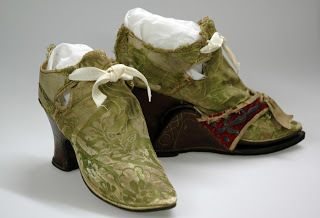 Susan reporting:
Susan reporting:While examples of 18th c. ladies' silk shoes like the pair, left, aren't rare (like these , these , and these ), shoes with a lurid ghost story attached certainly are. Know as the Papillon Shoes, this pair has a fascinating provenance that's more ghost story and legend than historical fact.
David Papillon (1681-1762) was a wealthy courtier and the master of Papillon Hall, Leicestershire, lower right. "Old Pamp"'s reputation for drunken debauchery was enhanced with whispers that he was friends with the Devil, and that he possessed demonic powers sufficient to paralyze his enemies with a single glance. Other rumors claimed he kept a beautiful Spanish mistress at the Hall. There she was a virtual prisoner, locked away in the attic, and only permitted to walk along the roof for exercise. She disappeared under mysterious circumstances in 1717; one story had her die in the attic, cursing the house and promising death and disaster to any owner who dared remove the shoes in which she'd walked the lonely roof.
Soon afterwards, Papillon left the Hall permanently to marry and live with his new wife in Kent. Some judged his haste suspicious, especially considering that he left strict instructions that certain items should never be taken from Papillon Hall. Among them were these shoes.
Over the years, the Hall changed hands many times. In the mid-19th c., however, the contents (including the shoes) were left to the old owner's daughter, and removed from the house. The new owners were at once plagued with unexplained loud thumps, crashes, and voices coming from the attic rooms, violent enough to terrify the family and servants. A local clergyman recalled Old Pamp's stipulation. The shoes were found and restored to the house, and peace restored with them. On several other occasions in the next century the shoes were removed from the house. Each time poltergeist activity began and continued until the shoes were returned.
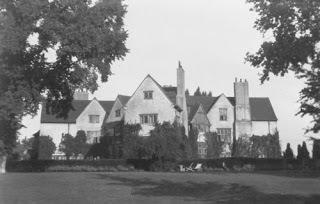 The Hall was renovated in 1903, and a long-dead body was found hidden in the walls near the attic. While there was no way to know for sure if this was Old Pamp's mistress, the discovery fueled the legend, and more reports of paranormal activity with it. Even after the Hall fell into disrepair and was demolished in 1950, the mistress's curse seemed to shift to the remaining outbuildings, terrifying their inhabitants. The site was studied by paranormal investigators, who definitely came to believe in the curse.
The Hall was renovated in 1903, and a long-dead body was found hidden in the walls near the attic. While there was no way to know for sure if this was Old Pamp's mistress, the discovery fueled the legend, and more reports of paranormal activity with it. Even after the Hall fell into disrepair and was demolished in 1950, the mistress's curse seemed to shift to the remaining outbuildings, terrifying their inhabitants. The site was studied by paranormal investigators, who definitely came to believe in the curse.After the Hall was knocked down, the shoes were left first to a Papillon descendant, and then to the local museum. Yet even that mundane transfer had its mysteries. The driver of the truck carrying the shoes became inexplicably lost. The short trip took him hours instead of minutes to complete, and when he finally did arrive, he was confused and disoriented, without any knowledge of where he'd been or what had happened. Ahh, the power of the shoes....
Above: Papillon Shoes (with single patten), silk with red leather heels, c. 1715-30. Collections Resources Centre, Heritage Services, Glenfield, Leicestershire
Below: View of Papillon Hall, built c. 1622, now demolished. Photograph courtesy of Lost Heritage.
Published on July 31, 2018 15:23
July 29, 2018
Happy 155th Birthday, Henry Ford
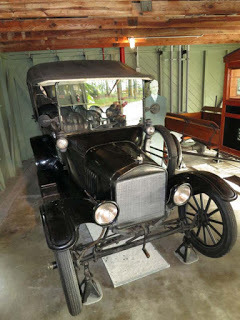
Loretta reports:
Today, 30 July, is automaker Henry Ford’s birthday. I’ve shown you some parts of the Fort Myers, Florida estate he shared with inventor Thomas Edison, here , here , and here .
I’ve also pointed out the way that the motorcar was quickly adopted for long-distance travel, even though the cars broke down frequently, roads could be little more than wagon tracks, and gas stations and auto mechanics were unheard of. But none of these obstacles stopped American from getting on the road and going—either on cross-country races or south, for warmer weather. With the advent of affordable autos came the Snowbirds—the Tin Can Tourists I posted about here and here .
All the same, I didn’t really know much about Ford beyond what little we learned (and mostly forgot) in school, back in the last century, about U.S inventors and innovators.
But I happened on this feature (please scroll down to the second article) at the Library of Congress site, which puts Ford and his world into perspective. Along with songs and recollections, it also provides an early film of an automobile parade—which was probably not the horse’s favorite experience that day.
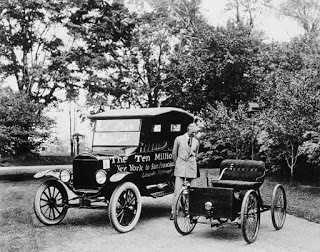 First & ten millionth Ford 1924
First & ten millionth Ford 1924
Sharp-eyed readers will note the “Ford Song” by one “A. Flivver, composer.” Flivver is early 20th century slang for an automobile.
Images: Photo above left 1919 Model T at Edison-Ford estate, Photo copyright © 2018 Walter M. Henritze III. At right, First and ten millionth Ford (1924), courtesy Library of Congress Prints and Photographs Division Washington, D.C. 20540 USA.
Clicking on the image will enlarge it. Clicking on the caption will take you to the source, where you can learn more and enlarge images as needed.
Published on July 29, 2018 21:30
July 28, 2018
Breakfast Links: Week of July 23, 2018
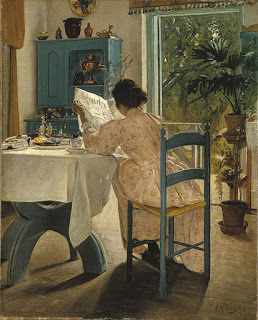 Breakfast Links are served! Our weekly round-up of favorite links to other web sites, articles, blogs, and images via Twitter.
Breakfast Links are served! Our weekly round-up of favorite links to other web sites, articles, blogs, and images via Twitter.• "I am half agony, half hope": Did you know that Jane Austen considered a different ending for Persuasion ?
• Singerie : 18thc art depicting monkeys "aping" human behavior.
• Elizabeth Gould , 19thc natural history artist who traveled to Australia to execute thousands of exquisite paintings of Australian birds for her husband's publication.
• The history of that striped Breton knit shirt you've been wearing all summer.
• Faustina , Marquesa de Amboage: the ideal woman of 1899.
• Before the bookmobile: when librarians rode on horseback to deliver books to rural Americans during the Great Depression.
• Mother Goose as a Suffragette : a 1912 book of suffragette poems, digitized to read online.
• " Talking corpses ": even in death, women's testimony was considered less creditable than men's.
• Puritan history-myths from the 17thc: did Oliver Cromwell ban mince pies ?
• Image: Lovely Winterhalter painting of the linked hands of Queen Victoria and Prince Albert.
• The mysterious death of Captain Archibald Anderson.
• The colorful, historical vocabulary of beer .
• These are the world's oldest known surviving pants , dating from the thirteenth to eleventh century BC.
• It was a dark and stormy night: the strange story of " Shelley's Ghost. "
• Make your own cockatrice - a terrifying animal hybrid!
• The radioactive wardrobe of Marie Curie .
• A 19thc children's picture book - in a can.
• The roots of the Hawaiian aloha shirt .
• Just for fun: Charlotte Brontë goes to yoga.
Hungry for more? Follow us on Twitter @2nerdyhistgirls for fresh updates daily.
Above: At Breakfast by Laurits Andersen Ring. Private collection.
Published on July 28, 2018 14:00
July 26, 2018
Friday Video: The Odyssey by Thug Notes
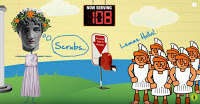 Loretta reports:
Loretta reports:Back in January, I alerted you to Emily Wilson's new translation of Homer's Odyssey , the first in English by a woman. Since then I’ve been reading it in installments, puzzling over the hero especially, and what drives him, as well as the culture in which the story lives.
This video offers some interesting insights as well as laughs. However, since it’s part of the Thug Notes series, be warned that the language is not delicate.
Video: Homer's Odyssey - Thug Notes Summary and Analysis
Readers who receive our blog via email might see a rectangle, square, or nothing where the video ought to be. To watch the video, please click on the title to this post (which will take you to our blog) or the video title (which will take you to YouTube).
Image at top left is a still from the video.
Published on July 26, 2018 21:30
July 25, 2018
The Long-Lost Slippers of Pauline Bonaparte Borghese, Princess of Sulmona, 1820
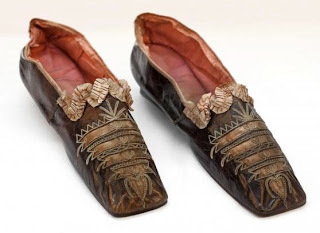 Susan reports,
Susan reports,It's a known fact that Loretta and I have a Thing for shoes (it says so right up there, under the blog's title.) When we come across shoes that also have a history - like these or these - we're in heaven. And when there may be a mysterious romance tossed in with the history – well, we can't ask for more, can we?
Dating from the 1820s, the leather slippers, trimmed with now-faded silk, left, were recently "rediscovered" in the King's Museum, University of Aberdeen. As occasionally happens in even the best of collections, these shoes had been long ago tucked away and forgotten, until an enterprising curatorial assistant, Louise Wilkie, came across them, and researched their background to be able to identify them as they prize they are.
The slippers have been identified as having belonged to Pauline Bonaparte Borghese (1780-1825), below right, Princess of Sulmona and sister of Napoleon Bonaparte. One clue was an old engraving on the shoes' soles: "Pauline, Rome Jan 20 1824." Another was the diminutive size of the shoes themselves, equivalent to a UK child's size 2; Pauline was famously known to have very small feet.
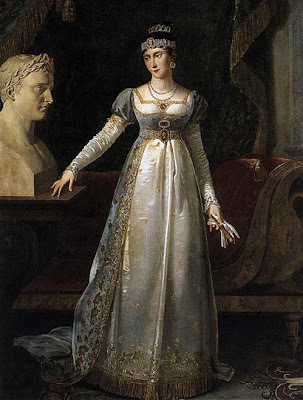
But Ms. Wilkie discovered a much stronger connection. The shoes were included in a collection of belongings of Robert Wilson (1787-1871.) Born in Banffshire, Scotland, Wilson served for several years as a ship's surgeon with the Honorable East India Company. The experience quelled his interest in medicine, but made him into an intrepid traveller. His journeys took him throughout Europe as well as to Egypt, Syria, Arabia, and India - all the more extraordinary given the unsettled times in which he was travelled.
While visiting Italy in 1820, he met and formed a close friendship with Pauline. Exactly how close they became remains a tantalizing mystery, even given Pauline's reputation for sexual adventures with many lovers. Still, entries like this one in Wilson's diary hint at their intimacy: "I passed a fortnight in the vicinity of Pisa with the Princess Borghese in a state of almost perfect seclusion, and afterwards accompanied her to the Baths of Lucca."
Perhaps the Princess found the straight-forward Scotsman a refreshing change from her more exotic lovers. Perhaps they simply were friends, and no more. But she did give him many gifts, including these slippers, as mementos – mementos that he carefully packed away and saved for the remainder of his long life, and bequeathed with his papers to the university at his death.
Above left: Slippers belonging to Pauline Borghese, King's Museum, University of Aberdeen.
Bottom right: Princess Pauline Borghese, by Robert Lefevre, c. 1808. Palace of Versailles.
Published on July 25, 2018 17:48
July 23, 2018
A Wife Mourned
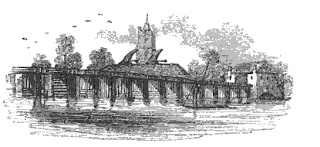 Loretta reports:
Loretta reports:During last summer’s trip to London, we visited many of the sites used or intended to be used in my new Difficult Dukes series. On one amazing day, which began at Wimbledon, we explored the environs of Putney Bridge aka Fulham Bridge, whose predecessor is a sort of secondary character in this series. It's believed to be the only bridge in England with a church at each end. We visited both. All Saints Church in Fulham is where we landed towards the end of the day.
“Putney Bridge cost upwards of £23,000; it is not only a disgrace to the neighbourhood, considered as an object of use and necessity, but is most dangerous to boats upon the river: the Ferry (which is still used) is mentioned in Doomsday-Book, as yielding an annual toll of 20s.—in 1729 its produce was four-hundred pounds. Immediately opposite to Putney stands Fulham, a mean town, noticeable only from its possessing a Palace of the Bishops of London, and a Church, in which are some monuments of eminent men.”—Arthur Freeling, Picturesque Excursions ; containing views at and near places of popular resort; with descriptions of each locality, 1842 (black & white image is from this book)
The church, which receives only this passing reference—after the slap at the town—is quite lovely, inside and out, and as the day was fading, we had the special treat of hearing choir practice.
There were, as there always are, poignant messages on the stones of the churchyard. But this one struck us as both touching and ... odd.
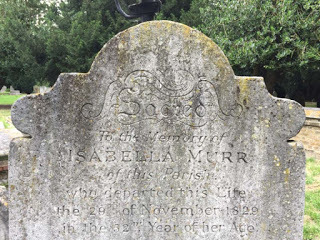
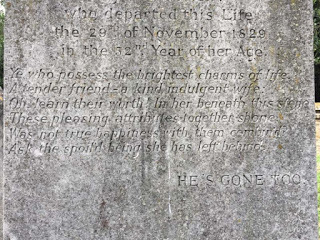 Depending on your screen, you might find it a little hard to read. Transcription below:
Depending on your screen, you might find it a little hard to read. Transcription below:“Sacred to the Memory of ISABELLA MURR
of this Parish
who departed this Lifethe 29th of November 1829
in the 52nd Year of her Age.
Ye who possess the highest charms of life:
A tender friend - a kind indulgent wife:
Oh, learn their worth! In her beneath this stone
These pleasing attributes together shone.
Was not true happiness with them combin’d?
Ask the spoil’d being she has left behind.
HE’S GONE TOO.You can learn more about the bridge and see a number of images at the London Borough of Hammersmith & Fulham Library Service’s blog here and here .
Photographs copyright © 2018 Walter M. Henritze III
Please click on images to enlarge.
Published on July 23, 2018 21:30
July 22, 2018
From the Archives: What Every Woman Should Know About Wearing Hoop Skirts - in 1938
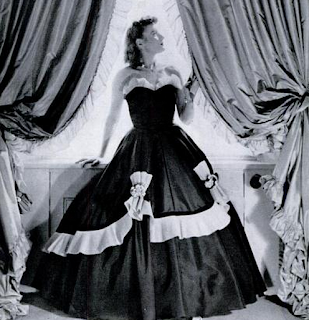 Susan reporting,
Susan reporting,Fashion repeats itself, and supporting skirts from beneath - whether by a farthingale, hoops, or a crinoline, depending on the century - is a style that keeps coming back. We've featured it here on the blog many times, including here and here .
But until I came across this feature from a 1938 Fall Fashion issue of Life Magazine, I'd no idea that hoops had also had a brief resurgence for evening wear in the late 1930s, an era that I'd always thought was defined by slinky, body-conscious bias-cut gowns.
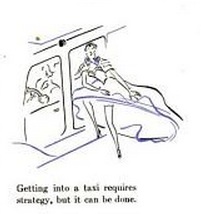
The editorial copy in Life describing this "new" fashion in dance frocks, above left, is amazingly snarky, even for fashion reporting, including this gem: "American women, notoriously hippy, are expected to pounce upon the bell-shaped silhouette. The nipped-in waist, the wide-spreading skirt, are perfect camouflage for excess pounds below the waist...." And this was from a mainstream American magazine!
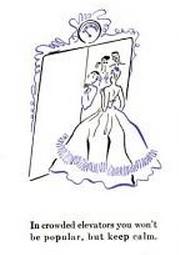 I also loved how these small, sarcastic cartoons that illustrate the perils of wearing a hoopskirt in the 1930s were so similar to the challenges facing the
Victorian ladies
in their crinolines, as well as this poor 18th c. lady
betrayed by her hoops.
It made me think of what a 2018 fashionista would face if the cycle of fashion brings back hoops again: imagine wrestling the things through a modern airport security check, or onto a stool at Starbucks. But you never know....
I also loved how these small, sarcastic cartoons that illustrate the perils of wearing a hoopskirt in the 1930s were so similar to the challenges facing the
Victorian ladies
in their crinolines, as well as this poor 18th c. lady
betrayed by her hoops.
It made me think of what a 2018 fashionista would face if the cycle of fashion brings back hoops again: imagine wrestling the things through a modern airport security check, or onto a stool at Starbucks. But you never know....Click here to read the entire feature on Fall Fashion, available online courtesy of GoogleBooks - including what must have been a pretty racy photoshoot of a model in a revealing black hoop petticoat and corset.
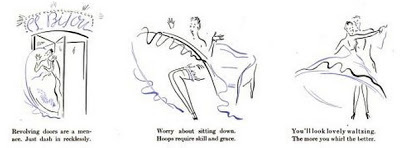 Top: "A hoop hangs under this black taffeta dress with blue ruchings", photo from Life Magazine, Sept. 5, 1938.
Top: "A hoop hangs under this black taffeta dress with blue ruchings", photo from Life Magazine, Sept. 5, 1938.Below: "What Every Girl Should Know About Wearing Hoopskirts", illustrations from Life Magazine, Sept. 5, 1938.
Published on July 22, 2018 17:02
July 21, 2018
Breakfast Links: Week of July 16, 2018
 Breakfast Links are served! Our weekly round-up of favorite links to other web sites, articles, blogs, and images via Twitter.
Breakfast Links are served! Our weekly round-up of favorite links to other web sites, articles, blogs, and images via Twitter.• Literary dreams: the 1903 Carnegie Library in Elwood, IN is for sale.
• An account of Peggy Jones , a Regency-era London mud-lark.
• In search of abandoned African-American cemeteries and the stories behind them.
• How two hundred stitches in time saved the lining of an 18thc banyan .
• The last summer of White Court, President Calvin Coolidge's summer White House.
• Video: Cozy accommodations for the most miniature of miniature books in the Newberry Library.
• Has supper always meant dinner ?
• Beautiful sky blue 1870s silk faille dress , made in Paris.
• How Abigail Adams and Thomas Jefferson became friends - and what finally destroyed the friendship.
• The funeral of Elizabeth Valois , Queen of Spain, 1568.
• Dangerous beauty: new exhibition looks at Medusa in Classical Art.
• The heatwave of 1808.
• The changing place-names of • Earl Grey tea: a splendid cup of tea with a tasty tale of creation.
• Why NYC needs a tribute to Nellie Bly, 19thc travel writer and journalist, and the original "fearless girl."
• What beds were like in 1776.
• Who will save this old 1840s stone schoolhouse, originally built and given for the education of the children in Hackney?
• Favorite story-tweet of the week features a 95-year-old former firefighter.
Hungry for more? Follow us on Twitter @2nerdyhistgirls for fresh updates daily.
Above: At Breakfast by Laurits Andersen Ring. Private collection.
Published on July 21, 2018 14:00
July 19, 2018
Friday Video: 18thC Working Women in Summer
Susan reporting,
Here's another short video from our friends at Crow's Eye Productions, featuring two young rural women from 18thc Britain and how they dress for their day as harvest workers. I have to admit that they don't seem to be working particularly hard, but then they'll be working from dawn to dusk, so maybe they're pacing themselves.
Thanks to producer/costume designer Pauline Loven for sharing with us!
If you received this post via email, you may be seeing an empty space or a black box where the video should be. Click here to view the video.
Published on July 19, 2018 21:00
From the Archives: Dining in July 1815
Loretta reports:
Since we had a short video about 18th and early 19th C dining last week, now seemed like good time to bring back this post on what foods were available in July during the Regency era.
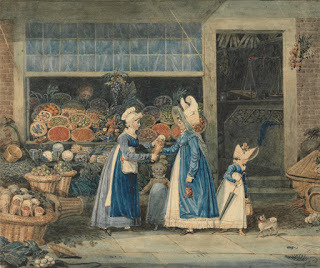 The Greengrocer
The Greengrocer
From The Epicure’s Almanack July Alimentary Calendar:
~~~The heats of the season now impose the necessity of occasionally substituting a light vegetable diet for the more solid gratification of animal food ... Cauliflowers, artichokes, green-peas, French-beans, Windsor* and other garden beans, frequently form a conspicuous part of the family dinner, to which butcher’s meat, in moderate quantities, may be said to serve merely as an auxiliary stimulant. Ham, bacon, and tongues, as well as ducks and geese, are the most seasonable viands for this purpose ... On festive occasions venison and turtle retain their pre-eminent station at the tables of the opulent, where also the fawn ... forms an elegant dish, when roasted whole and served up with rich gravy. Veal, having now been fed on milk, in its richest state, is peculiarly fine and well flavoured; but care should be taken that it be delivered fresh to the cook, as it is more liable to suffer from the heat of the weather and from flies than any other kind of meat. Ragouts of sweetbreads, oxpalates, lambs’ bits, fat livers, and cocks’-combs, are among the light dishes introduced at superior tables; where also various preparations of curry afford a delectable repast to those who have acquired a taste for this Indian diet.
...
... a plenteous and varied dessert presents itself at this season; consisting of pines, melons, peaches, cherries, grapes, currants, gooseberries and raspberries, as well as early apples and pears. Fruit is certainly most salubrious in hot weather; but, if the opinion be well founded that it does most good when taken before dinner, the dessert ought to take place of that spurious meal called lunch, which, being usually made of animal food, too often banishes the appetite irrecoverably for the day.
~~~*broad beans
Excerpted from The Epicure's Almanack: Eating and Drinking in Regency London (The Original 1815 Guidebook).
Image: James Pollard, The Greengrocer (ca 1819) courtesy Yale Center for British Art, Paul Mellon Collection.
Clicking on the image will enlarge it. Clicking on the caption will allow you to read at the source, where you can learn more and enlarge images as needed.
Since we had a short video about 18th and early 19th C dining last week, now seemed like good time to bring back this post on what foods were available in July during the Regency era.
 The Greengrocer
The Greengrocer
From The Epicure’s Almanack July Alimentary Calendar:
~~~The heats of the season now impose the necessity of occasionally substituting a light vegetable diet for the more solid gratification of animal food ... Cauliflowers, artichokes, green-peas, French-beans, Windsor* and other garden beans, frequently form a conspicuous part of the family dinner, to which butcher’s meat, in moderate quantities, may be said to serve merely as an auxiliary stimulant. Ham, bacon, and tongues, as well as ducks and geese, are the most seasonable viands for this purpose ... On festive occasions venison and turtle retain their pre-eminent station at the tables of the opulent, where also the fawn ... forms an elegant dish, when roasted whole and served up with rich gravy. Veal, having now been fed on milk, in its richest state, is peculiarly fine and well flavoured; but care should be taken that it be delivered fresh to the cook, as it is more liable to suffer from the heat of the weather and from flies than any other kind of meat. Ragouts of sweetbreads, oxpalates, lambs’ bits, fat livers, and cocks’-combs, are among the light dishes introduced at superior tables; where also various preparations of curry afford a delectable repast to those who have acquired a taste for this Indian diet.
...
... a plenteous and varied dessert presents itself at this season; consisting of pines, melons, peaches, cherries, grapes, currants, gooseberries and raspberries, as well as early apples and pears. Fruit is certainly most salubrious in hot weather; but, if the opinion be well founded that it does most good when taken before dinner, the dessert ought to take place of that spurious meal called lunch, which, being usually made of animal food, too often banishes the appetite irrecoverably for the day.
~~~*broad beans
Excerpted from The Epicure's Almanack: Eating and Drinking in Regency London (The Original 1815 Guidebook).
Image: James Pollard, The Greengrocer (ca 1819) courtesy Yale Center for British Art, Paul Mellon Collection.
Clicking on the image will enlarge it. Clicking on the caption will allow you to read at the source, where you can learn more and enlarge images as needed.
Published on July 19, 2018 09:47



